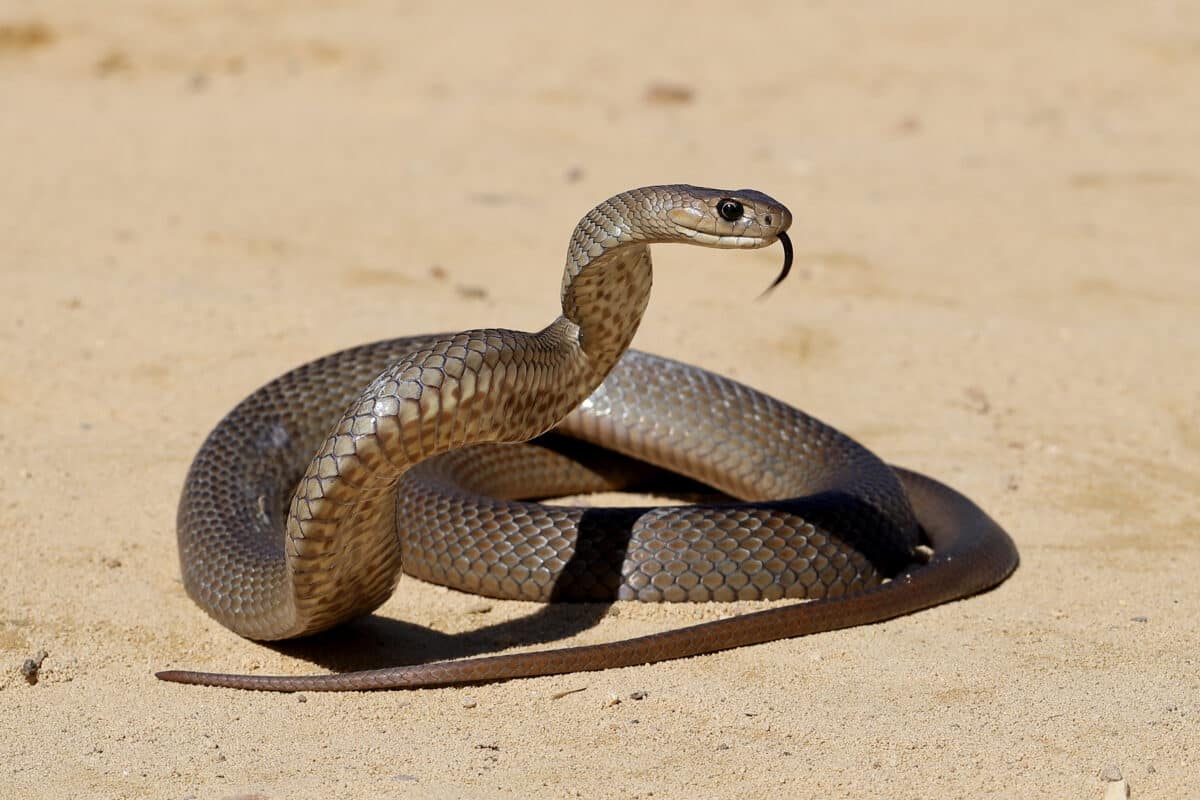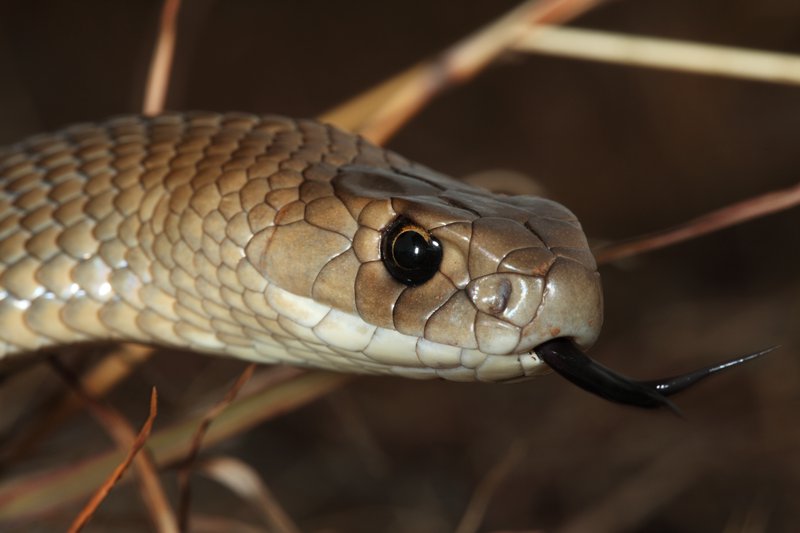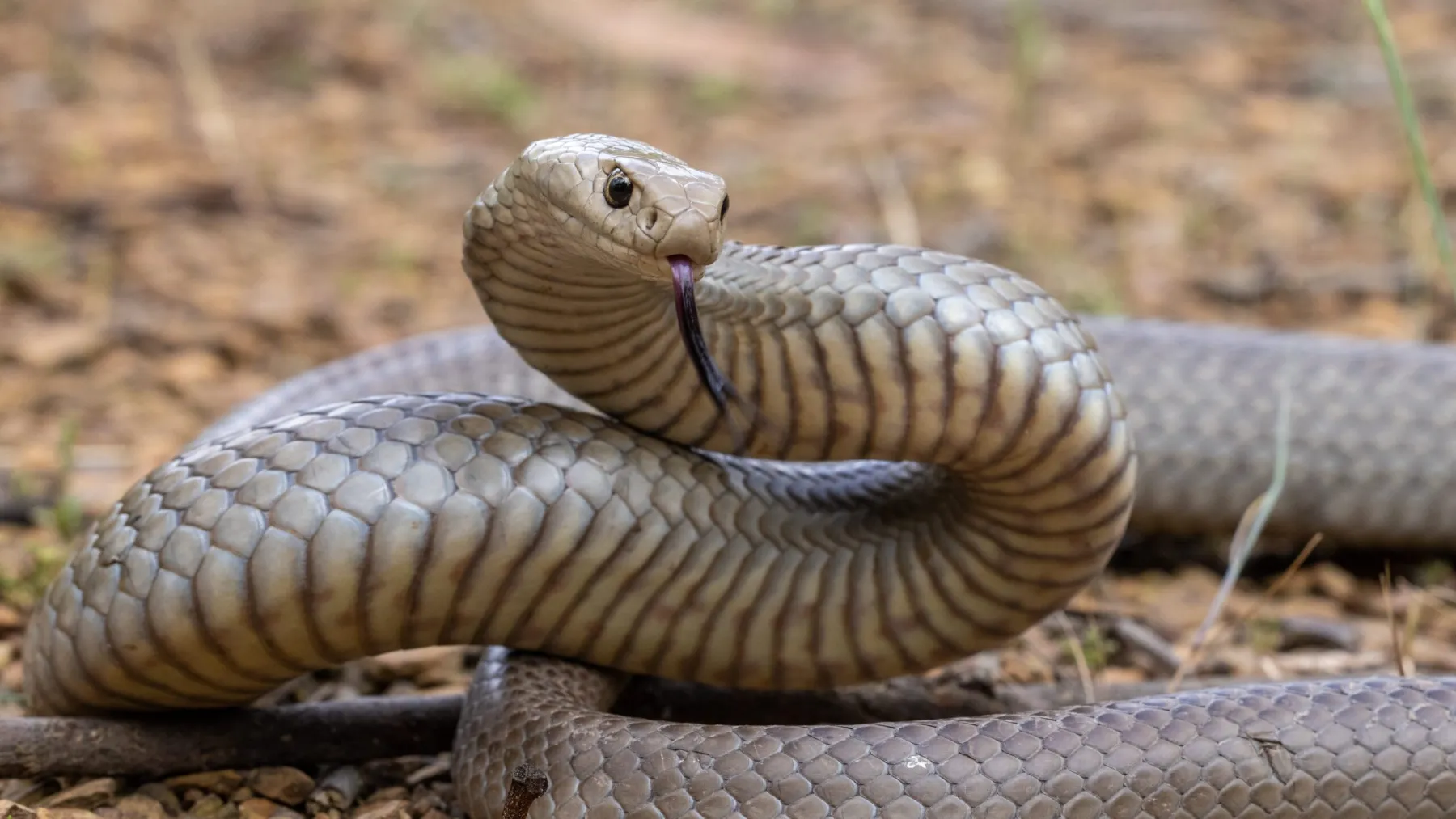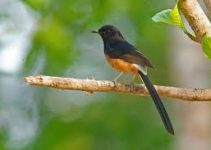Contents
- 1 Physical Characteristics and Habitat of the Eastern Brown Snake
- 2 Venom and Its Effects on Humans and Animals
- 3 Eastern Brown Snake’s Hunting Behavior and Diet
- 4 Reproduction and Lifespan of the Eastern Brown Snake
- 5 Distribution and Prevalence of the Eastern Brown Snake in Australia
- 6 Eastern Brown Snake Bites: Symptoms, First Aid, and Medical Treatment
- 7 Tips for Preventing Encounters with the Eastern Brown Snake
- 8 Conservation Efforts and Protection of the Eastern Brown Snake
- 9 Conclusion: Understanding and Respecting the Eastern Brown Snake
- 10 Author
G’day mate! Welcome to the captivating world of the Eastern Brown Snake, Australia’s stealthy killer. Slithering through the rugged Australian landscapes, this highly venomous serpent is certainly not to be taken lightly. With a maximum length of over two meters, it quietly blends into its surroundings with its cryptic coloring.
Feared for its potent venom, the Eastern Brown Snake is responsible for more deaths each year in Australia than any other snake. Its strikes are lightning-fast and deadly accurate, making it one of the most dangerous snakes in the world. Its sharp fangs inject a potent neurotoxic venom, which can cause paralysis, cardiac arrest, and organ failure within minutes if left untreated.
But beyond its terrifying reputation, the Eastern Brown Snake also serves a vital role in the ecosystem. As an apex predator, it helps control the population of small mammals and other reptiles. Join us as we explore the secretive life of the Eastern Brown Snake, its habitat, hunting habits, and the measures taken to coexist with this fascinating yet deadly creature. Beware, though – this article might leave you with a newfound respect for Australia’s remarkable wildlife. So, grab your snake boots and let’s delve into the intriguing world of the Eastern Brown Snake!
Physical Characteristics and Habitat of the Eastern Brown Snake
The Eastern Brown Snake is a remarkable creature, easily identifiable by its striking coloration and physical features. These snakes typically exhibit a range of colors from a light brown to a dark chocolate hue, often with a subtle sheen. This variation allows them to blend seamlessly into their environment, whether it is the dry bushland or the urban gardens they often inhabit. Their slender bodies can reach impressive lengths, with some individuals exceeding two meters, making them one of the largest venomous snakes in Australia.
Their heads are relatively small compared to their bodies, with a distinct wedge shape that aids in their identification. The eyes of the Eastern Brown Snake are also noteworthy; they possess round pupils, and their gaze is keen, allowing them to detect movement and potential prey from a distance. The scales of the Eastern Brown Snake are smooth and glossy, contributing to its ability to glide effortlessly through the grass, underbrush, and other terrains. These physical traits not only enhance their appearance but also assist in their survival as mancingduit stealthy predators.
In terms of habitat, the Eastern Brown Snake is highly adaptable. They can be found across various environments, including forests, grasslands, and even suburban areas. Their ability to thrive in human-dominated landscapes has brought them into closer contact with people, which can often lead to dangerous encounters. During the day, these snakes may be found basking in the sun or hidden beneath leaf litter, rocks, and logs. As night falls, they become more active, hunting for food and exploring their surroundings.

Venom and Its Effects on Humans and Animals
The venom of the Eastern Brown Snake is one of its most lethal attributes, primarily composed of potent neurotoxins and coagulants. These components work in tandem to disrupt the normal functioning of the nervous system and blood clotting mechanisms. Upon envenomation, the effects can be devastating, leading to symptoms such as paralysis, respiratory failure, and uncontrolled bleeding. The severity of these symptoms can escalate rapidly, often within minutes, highlighting the urgent need for medical attention following a bite.
Interestingly, the venom’s composition can vary between individual snakes, influenced by factors such as age, diet, and geographical location. Research indicates that young Eastern Brown Snakes possess venom that is more toxic than that of adults, making bites from juvenile snakes particularly dangerous. The venom’s potency is a key reason the Eastern Brown Snake is responsible for more fatalities in Australia than any other snake species, making awareness and education crucial for those living in or visiting its range.
For animals, the venom serves a similar purpose: immobilizing prey and enabling the snake to consume its meal. Small mammals, birds, and other reptiles fall victim to this stealthy predator, which relies on its quick strikes and venom to subdue prey. The ecological impact of the Eastern Brown Snake extends beyond its hunting prowess; by controlling rodent populations and other small animals, it plays a vital role in maintaining the balance of its ecosystem.
Eastern Brown Snake’s Hunting Behavior and Diet
The hunting behavior of the Eastern Brown Snake is a marvel of efficiency and stealth. These snakes are primarily ambush predators, employing a strategy of remaining motionless and waiting for unsuspecting prey to come within striking range. Their remarkable speed and agility allow them to launch lightning-fast strikes, capturing small mammals, birds, and occasionally other reptiles in a matter of seconds. Once the prey has been bitten, the venom quickly takes effect, immobilizing it and allowing the snake to consume its meal at leisure.
The diet of the Eastern Brown Snake is diverse, reflecting its adaptability and opportunistic nature. Common prey includes rodents, such as mice and rats, which often inhabit the same areas as the snakes. Birds and their eggs are also on the menu, particularly in environments where these creatures are abundant. In some instances, Eastern Brown Snakes have been observed consuming other snakes, showcasing their predatory prowess. This varied diet not only sustains the Eastern Brown Snake but also contributes to the ecological balance by controlling populations of potential pest species.
Interestingly, Eastern Brown Snakes have been known to exhibit a level of intelligence when hunting. Some studies suggest that they can learn from their experiences, improving their hunting techniques over time. Their ability to navigate complex environments and adapt their strategies is a testament to their evolutionary success. While their hunting methods are highly effective, it is the combination of their stealth, speed, and venom that solidifies their reputation as one of Australia’s most formidable predators.
Reproduction and Lifespan of the Eastern Brown Snake
The reproductive cycle of the Eastern Brown Snake is a fascinating aspect of their biology. Mating typically occurs in the spring, after the snakes emerge from hibernation. Male Eastern Brown Snakes are known to engage in competitive displays, using physical prowess to assert dominance over other males. This competition often involves wrestling matches, where they coil around each other in a display of strength. The winner earns the right to mate with a female, ensuring that the strongest genes are passed on to the next generation.
After a successful mating season, the female Eastern Brown Snake will lay a clutch of eggs, typically ranging from 10 to 30. These eggs are laid in a warm, moist environment, often hidden within decaying vegetation or under logs. The incubation period lasts approximately two to three months, during which time the female will often leave the eggs to fend for themselves. Once hatched, the juvenile snakes emerge fully formed and equipped with venom, ready to face the challenges of the world.
In terms of lifespan, Eastern Brown Snakes can live for around 10 to 15 years in the wild, although some individuals have been known to live longer in captivity. Factors such as predation, habitat loss, and human encounters can significantly impact their lifespan in natural environments. Despite their many challenges, the Eastern Brown Snake continues to thrive, adapting to changes in their habitat and maintaining their role as a key predator in Australia’s ecosystems.

Distribution and Prevalence of the Eastern Brown Snake in Australia
The Eastern Brown Snake is widely distributed across various regions of Australia, making it one of the most common and recognizable snake species in the country. Its range extends from the eastern states, including Queensland, New South Wales, and Victoria, through to parts of South Australia and the Northern Territory. This broad distribution is a testament to its adaptability and resilience in diverse environments, from coastal areas to arid inland regions.
In urban settings, Eastern Brown Snakes are frequently encountered due to their tendency to inhabit gardens, parks, and rural properties. Their ability to thrive in human-dominated landscapes has led to an increase in reported encounters, which can often result in fear and misunderstanding. While these snakes are generally shy and prefer to avoid humans, their presence in populated areas serves as a reminder of the need for coexistence and respect for wildlife.
The prevalence of the Eastern Brown Snake also raises important conservation issues. Habitat destruction, climate change, and human encroachment threaten their populations, prompting the need for conservation efforts to protect these remarkable snakes. Understanding their distribution and ecological role is crucial for developing strategies to ensure their survival and mitigate human-snake conflicts. As we delve deeper into the world of the Eastern Brown Snake, it becomes evident that preserving their habitats is essential for maintaining the delicate balance of Australia’s ecosystems.
Eastern Brown Snake Bites: Symptoms, First Aid, and Medical Treatment
Encounters with the Eastern Brown Snake can lead to potentially life-threatening situations, particularly if a bite occurs. Understanding the symptoms of a bite is critical for timely medical intervention. Initial signs may include intense pain at the bite site, swelling, and discoloration. As time progresses, more severe symptoms such as dizziness, difficulty breathing, and paralysis may manifest, indicating the spread of venom throughout the body. In severe cases, victims can experience cardiac arrest and organ failure, underscoring the urgency of seeking medical help immediately.
First aid measures play a crucial role in managing snake bites until professional medical assistance is available. The primary recommendation is to keep the affected limb immobilized and below heart level to slow the spread of venom. Applying a pressure bandage above the bite site can help control swelling, but caution should be exercised to avoid cutting off circulation. It is essential to avoid sucking out venom or applying ice, as these methods can worsen the situation. Instead, the focus should be on getting the victim to a hospital as quickly as possible for antivenom treatment.
Medical treatment for Eastern Brown Snake bites typically involves the administration of antivenom, which can neutralize the effects of the venom and significantly reduce the risk of severe complications. Healthcare professionals will monitor the victim’s vital signs and may provide additional interventions based on the severity of symptoms. Prompt and effective medical care is crucial in improving outcomes and reducing the likelihood of long-term health issues resulting from a bite. Education and awareness about snake bite management are vital, especially in areas where encounters with Eastern Brown Snakes are more frequent.
Tips for Preventing Encounters with the Eastern Brown Snake
While the Eastern Brown Snake plays an essential role in the ecosystem, it is wise to take precautions to prevent encounters, especially in areas where they are prevalent. One of the most effective strategies is to create a snake-friendly environment in gardens and yards. Keeping grass trimmed short, removing debris and clutter, and sealing gaps in fences can reduce the likelihood of snakes taking up residence. Additionally, ensuring that food sources, such as rodent populations, are managed can help deter these snakes from entering your property.
When enjoying outdoor activities in areas known to be inhabited by Eastern Brown Snakes, it is essential to remain vigilant. Wearing appropriate footwear, such as high boots, can provide protection against potential bites. Additionally, sticking to well-trodden paths and avoiding tall grass and underbrush reduces the risk of accidental encounters. If you do come across a snake, it is crucial to remain calm and back away slowly; provoking the snake can lead to aggressive behavior.
Education and awareness are key components in preventing snake encounters. Understanding the habits and behaviors of the Eastern Brown Snake can help individuals recognize potential risks and respond appropriately. Communities can benefit from educational programs that promote coexistence with local wildlife, emphasizing the importance of respecting these fascinating creatures while prioritizing safety. By fostering a sense of understanding and respect, we can reduce the number of snake encounters and ensure a harmonious relationship with Australia’s remarkable wildlife.

Conservation Efforts and Protection of the Eastern Brown Snake
As urbanization and habitat loss continue to pose threats to the Eastern Brown Snake, conservation efforts are essential for ensuring their survival. Organizations and wildlife groups are actively working to raise awareness about the ecological importance of these snakes and the need for their protection. Educating the public about the role of Eastern Brown Snakes in controlling rodent populations and maintaining biodiversity is vital for fostering a sense of stewardship.
Habitat preservation is a crucial aspect of conservation initiatives, focusing on protecting natural environments where Eastern Brown Snakes thrive. This involves promoting sustainable land-use practices and preserving critical habitats to ensure that these snakes have access to suitable living conditions. Conservation programs may also include research initiatives aimed at understanding the population dynamics and behaviors of Eastern Brown Snakes, providing valuable insights for effective management strategies.
Community engagement plays a pivotal role in conservation efforts. Local residents can become advocates for wildlife protection by participating in programs that promote coexistence and responsible wildlife management. By fostering a culture of respect for nature and understanding the significance of the Eastern Brown Snake within the ecosystem, we can collectively contribute to their conservation. For those living in areas where these snakes are prevalent, participating in local wildlife surveys or volunteering with conservation organizations can be effective ways to make a positive impact.
Conclusion: Understanding and Respecting the Eastern Brown Snake
The Eastern Brown Snake is a remarkable creature that embodies the complexity and beauty of Australia’s wildlife. While its potent venom and stealthy hunting techniques evoke fear, it is essential to recognize the vital role this snake plays in maintaining the balance of its ecosystem. Understanding its habits, habitat, and contributions to biodiversity fosters a greater appreciation for this enigmatic serpent. If you like reading this article then consider visiting tirai to find more article like this.



